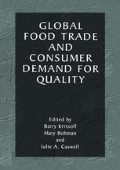Abstract
World poultry markets are one of the most rapidly growing sectors of the food industry. Poultry production rose from 11 million tons in 1965 to over 63 million tons in 1999. Consumption increases have exceeded population growth, with world per capita supplies of poultry meat tripling from 3.3 kilograms in 1965 to 9.9 kilograms in 1997. International trade has more than kept pace with this industry growth. World exports of poultry meat rose from 375,000 tons in 1965 to 6.4 million tons in 1999. Trade now accounts for about 10 percent of world consumption.
The views expressed in this chapter are not to be attributed to any of the institutions with which the authors are affiliated. We thank Mark Gehlhar of the Economic Research Service for data access and advice and Dale Colyer for comments on the draft chapter.
Access this chapter
Tax calculation will be finalised at checkout
Purchases are for personal use only
Preview
Unable to display preview. Download preview PDF.
References
Alston, J. M., and Scobie, G. M., 1987, Differentiated goods model of the effects of European policies in international poultry markets, Southern J Agric Econ 19(1):59–68.
Ames, G., 1998, Non-tariff barriers and political solutions to trade disputes: A case study of U.S. poultry exports to Russia, Rev Agric Econ 20 (I): 238–247.
Beck, R., Hoskins, C., and Mumey, G., 1994, The social welfare loss from egg and poultry marketing boards, revisited, Can J Agric Econ 42(1):149–158.
Calvin, L., and Krissoff, B., 1998, Technical barriers to trade: A case study of phytosanitary barriers and US-Japanese apple trade, J Agric Resour Econ 23(Dec.):35l-366.
Economic Research Service (ERS), U.S. Department of Agriculture, 1986, Embargos, Surplus Disposal, and U.S. Agriculture, Staff Report AGES860910, Washington, DC.
Food Safety and Inspection Service (FS1S), U.S. Department of Agriculture, 1995, Focus on Chicken, Consumer Education and Information Publication, http://www.fsis.usda.gov(accessed Apr. 29, 2001 ).
Goodwin, J. W., Madrigal, S., and Martin, J., 1998, Supply and Demand Responses in the U.S. Broiler Industry, Report 332, Arkansas Agricultural Experiment Station, Fayetteville.
Henry, R., and Rothwell, G., 1995, The World Poultry Industry, International Finance Corporation, Washington, DC.
Kahrs, R. F., 1996, The Threatened 1996 Russian Embargo on U.S. Poultry Meat Exports: Executive Summary and Recommendations, memo, Animal Plant Health and Inspection Service, U.S. Department of Agriculture, Washington, DC.
Kapombe, C. R., 1997, Broiler Exports: A Structural Time Series Approach, Ph.D. diss., West Virginia University, Morgantown.
Kapombe, C. R., 1998, Broiler exports: A structural time series approach, in: Trade Policy and Competition: Forces Shaping American Agriculture, Southern Cooperative Series Bulletin No. 390 (Nov.): 31–58.
Kapombe, C. R., and Colyer, D., 1998, Modeling U.S. broiler supply response: A structural time series approach, Agric Resour Econ Rev 27 (Oct.): 241–251.
Koo, W. W., and Golz, J. T., 1994, Competitiveness of broiler producers in North America under alternative free trade scenarios, Agribusiness 10 (6): 503–511.
Lasley, F. A., Short, S. D., and Henson, W. L., 1985, Economic Assessment of the 1983–84 Avian Influenza Eradication Program, AGES841212, Economic Research Service, U.S. Department of Agriculture, Washington, DC.
Michel, K., Gempesaw, C. M., II, and Biery, C. S., 1998, An Analysis of International Poultry Trade and Competitiveness, FREC RR 98–01, Food and Resource Economics, University of Delaware, Newark.
Orden, D., and Romano, E., 1996, The Avocado Dispute and Other Technical Barriers to Agricultural Trade under NAFTA, paper presented at NAFTA and Agriculture Conference, Nov. 1, 1996, San Antonio.
Roberts, D., Josling, T., and Orden, D., 1999, A Framework for Analyzing Technical Trade Barriers in Agricultural Markets, Technical Bulletin No. 1876, Economic Research Service, U.S. Department of Agriculture, Washington, DC.
Swayne, D. E., and Slemons, R. D., eds., 1997, Proceedings of the Fourth International Symposium on Avian Influenza, United States Animal Health Association, Athens, GA.
U.S. International Trade Commission (USITC), 1998, Industry and Trade Summary: Poultry, Pub. 3148, Office of Industries, Washington, DC.
Wakenell, P., and Jetter, K., 1999, Exotic Newcastle Disease Virus,Agricultural Issues Center, University of California, Davis.
Wang, Q., Fuller, F., Hayes, D., and Halbrendt, C., 1998, Chinese consumer demand for animal products and implications for U.S. pork and poultry exports, J Agric Appl Econ 30(I):127–140.
World Health Organization (WHO), 2000, Food Safety and Foodbome Illness, Fact Sheet No. 237, http://www.who.org(accessed Mar. 14, 2001).
World Trade Organization (WTO), 1997, United States-Measures Affecting Imports of Poultry Production: Request for Consultations by the European Communities, doc. symbol G/SPS/GEN/28, http://docsonline.wto.org(accessed Jul. 27, 2001 ).
World Trade Organization (WTO),1995–2000, Committee on Sanitary and Phytosanitary Measures meeting summaries, doc. symbol G/SPS/R, http://docsonline.wto.org(accessed Jul. 27, 2001 ).
Author information
Authors and Affiliations
Editor information
Editors and Affiliations
Rights and permissions
Copyright information
© 2002 Springer Science+Business Media New York
About this chapter
Cite this chapter
Orden, D., Josling, T., Roberts, D. (2002). Product Differentiation, Sanitary Barriers, and Arbitrage in World Poultry Markets. In: Krissoff, B., Bohman, M., Caswell, J.A. (eds) Global Food Trade and Consumer Demand for Quality. Springer, Boston, MA. https://doi.org/10.1007/978-1-4757-5329-5_8
Download citation
DOI: https://doi.org/10.1007/978-1-4757-5329-5_8
Publisher Name: Springer, Boston, MA
Print ISBN: 978-1-4419-3379-9
Online ISBN: 978-1-4757-5329-5
eBook Packages: Springer Book Archive

